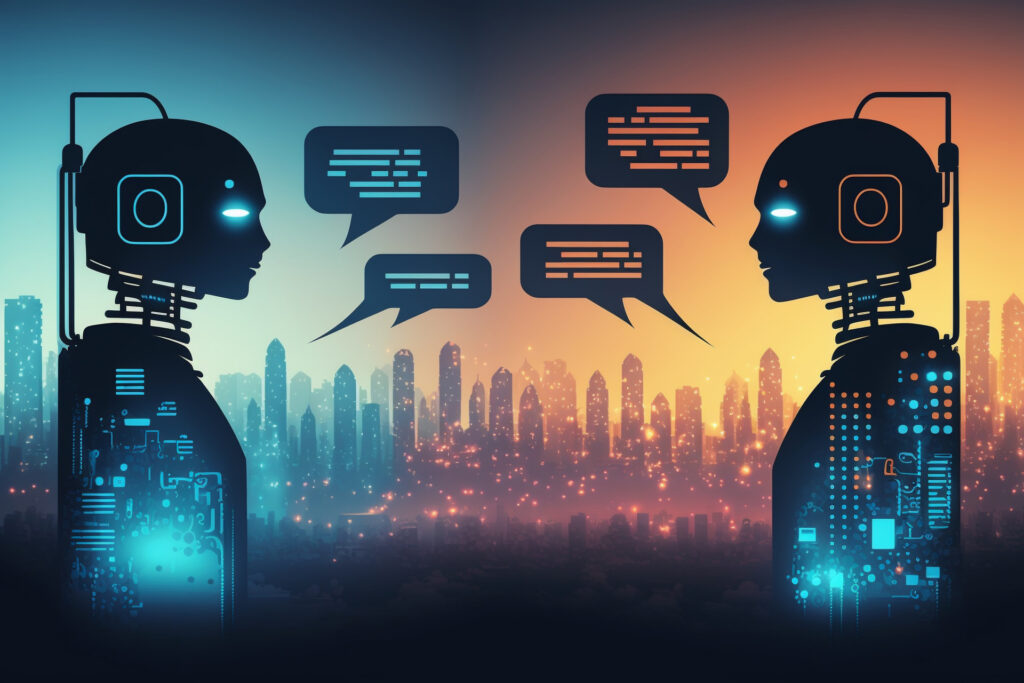Table of contents:
ChatGPT, Google Translate, Gemini—these are only a drop in the vast ocean of NLP applications. In 2016, Google Translate successfully processed more than 100 billion words on a daily basis, demonstrating the massive scale of NLP operations. With technology advancing at breakneck speed, machine learning is revolutionizing how we interact with computers. But how exactly is this innovative technology reshaping our daily lives?
We’ll dive into this world and explore its various uses. We’ll also study how it operates, provides solutions, and improves business operations. You’ll also learn how its advanced operation has influenced various industries. And in the end, we’ll analyze areas where machine language can improve AI technology.
What is NLP in AI?
In 1964, when the first chatbot, ELIZA, was created, it could only respond with pre-programmed patterns, often repeating user phrases as questions. Fast forward to today, and we have systems like GPT-4 for writing poetry, drafting legal documents, and even explaining complex physics concepts to children.
This evolution showcases how far we’ve come from the days when computers were merely calculators with keyboards. The Natural Language Processing Market is anticipated to experience significant growth over the forecast period, increasing from $18.9 billion in 2023 to $68.1 billion by 2028. This represents a robust compound annual growth rate (CAGR) of 29.3%.
Natural language processing in artificial intelligence changed how we see computers. Remember when computers first made waves? For the first time in human history, we had a working solution that spans across fields. But as the world grew, professionals saw this technology was capable of so much more.
One primary need emerged as humans increasingly relied on the internet. As more people sent prompts, engineers created artificial intelligence to meet these needs. But as impressive as it was, its relation to human needs was generic and mechanical at best. Therefore, engineers developed new features to analyze human requests and provide relevant solutions. Among the many results was natural language processing.
This technology is, at its core, the heart of artificial intelligence. It calculates and analyzes data to provide human-centric responses to inquiries. NLP and AI allow computers of all ages and types to work with human language at a monumental scale. Their algorithms let systems interpret the context in written or spoken human language.
Why is NLP Important in AI Technology?
The implementation of NLP in AI today changed how machines handle human queries. Plus, it takes data analysis and management to a whole new level. That’s why we enjoy these benefits of technology today:
Efficient Documentation
A major hospital in Boston reduced their documentation time by 60% by implementing NLP-powered medical transcription. Instead of doctors spending hours typing notes, they simply speak naturally, and the system automatically generates structured medical records.
Without Artificial Intelligence and Natural Language Processing (AI NLP), machines would handle human language as cold logic. But its introduction allows for better breakdowns of texts across fields. Now, technologies can categorize and summarize texts without losing context. Plus, they do it faster than any human ever could.
Higher Data-Handling Power
During the COVID-19 pandemic, researchers used NLP to analyze millions of scientific papers in days, helping identify potential treatments. The COVID-19 Open Research Dataset contained over 200,000 scholarly articles, which would have taken years to process manually.
Before AI, computers struggled to handle large volumes of data. Now, NLP and AI let systems compile and analyze complex tasks, no matter how wide the source is.
Improved Sentiment Analysis
Early AI technology struggled to understand human perceptions. But natural language processing models study demographics to dig out contexts and undertones.
Diverse Feature Options
The lack of a human-centric approach hampered technology in the past. Today, AI NLP enables users to explore a wide range of feature opportunities.
How NLP Improves AI Functions
NLP takes AI technology to another level. It ensures the system comprehends queries and provides accurate answers. The most prominent include:
Text Categorization & Extraction
Consider Amazon’s customer review system. When you write, “The delivery was quick, but the product quality was disappointing,” Natural Language Processing (NLP) systems automatically recognize it.
– Categorize this as a mixed review
– Extract “delivery speed” as positive
– Flag “product quality” as negative
– Route this feedback to relevant departments
Natural language processing uses algorithms to determine a text’s emotional context. Then, it categorizes texts based on this factor to generate a concise database. This enables it to assess and determine the intended meaning of an inquiry, post, or opinion piece.
Imagine the frequent mention of a brand’s name on various platforms. NLP can assess the type of emotion associated with it. Then, it uses the result to determine the brand’s perception across users. This also helps identify potential customers within the user base.
Natural Language Generation (NLG)
Picture The Wrapped feature on Spotify creates personalized stories about your listening habits. It doesn’t just list statistics; it crafts engaging narratives like “You’re in the top 0.1% of Taylor Swift listeners this year!” This is NLG in action, turning raw data into compelling stories.
NLP technology also creates texts that resonate with people on an emotional level. Generative AI NLP platforms like ChatGPT and Gemini provide examples of this phenomenon. This sorting of feedback analysis enables systems to respond to customer inquiries in the same manner as people do.
NLP AI systems also understand voice prompts. This explains why features like Bing Translator operate. Its function also allows record analysis, plagiarism detection, forecasting, and legal automation. Such tools can also detect spam by checking for misspellings and incorrect grammar.
Semantics
Ask Siri, “What’s the closest coffee shop that’s still open?” The system needs to:
- Understand “closest” requires location data
- Know “still open” refers to current business hours
- Identify “coffee shop” as a business category
- Compare multiple data points to provide relevant results
One major perk of NLP AI is its capacity to understand what words mean. Semantics enables technologies to interpret the meaning of a prompt through various techniques. One common option is Name Entity Recognition (NER). This categorizes texts into groups by checking names, places, and entities.
Another feature in natural language processing models is Word Sense Disambiguation. This checks the context behind certain sentences and categorizes them. When these combine, the system generates new texts that provide the most accurate responses. Therefore, the program communicates with users as if it were a human being.
Deep Learning
NLP AI needs to first study human language to become proficient at it. Therefore, engineers provide it with extensive datasets, which it processes to enhance comprehension. Deep learning, a process, enables systems to analyze human expressions for enhanced cognitive abilities. The more datasets it studies, the better it gets at understanding human perception. As it continues, it learns better ways to provide feedback to queries.
Industry Adoption of NLP in AI
NLP in AI has expanded technological reach across niches. Before, businesses had to keep specific tasks exclusive to human operations. But today, industries can use this analytical technology for anything. That’s why brands across these niches can now enjoy its use:
Finance
JP Morgan implemented an NLP system called COIN (Contract Intelligence) that reviews commercial loan agreements in seconds instead of 360,000 hours of lawyer time annually.
Thanks to AI NLP. Experts can extract client financial records faster using simple prompts. Automated financial analytics generate reports for better decisions. AI market analysis can dig up facts and churn predictions that match the info.
Healthcare
At a clinic, NLP systems analyze patient records to:
– Flag potential drug interactions
– Identify candidates for clinical trials
– Predict patient readmission risks
Natural language processing in AI compiles more electronic documents with less effort. For instance, some healthcare platforms feature automated diagnosis. Patients answer simplified surveys and forms, stating their symptoms. The system crunches the data to provide a diagnosis plus recommended treatments.
Insurance
Consider this: NLP and computer vision collaborate when you submit an auto insurance claim with photos of your damaged car.
– Analyze damage descriptions
– Compare with similar past claims
– Estimate repair costs
– Flag potential fraud
AI NLP allows systems to sort paperwork details based on specified factors. Businesses can also create online forms that categorize clients based on given factors. This industry thrives because it operates with a massive inflow of information.
Retail
AI NLP enables businesses to predict the shopping habits of prospects. Now, platforms can make tailored recommendations and offer faster solutions.
Legal
Natural language processing in AI reduces administrative tasks through sentimental categorization. Lawyers can now attend to cases based on urgency and proximity to court dates.
Customer Service
Previous computer technologies needed humans in the background for all tasks. But AI natural language processing changed all that. It allows you to handle customer queries using chatbots and virtual assistants.
The Future of NLP in AI Technology
Imagine these emerging scenarios:
– Mental health apps that detect early signs of depression through voice analysis
– Real-time translation earbuds that maintain cultural context and idioms
– Legal AI that can draft contracts while explaining complex clauses in plain language
– Education systems that adapt their teaching style based on student sentiment and engagement
As of 2024, the projected revenue for the global Natural Language Processing market is expected to reach $37.1 billion. This market has shown significant growth, with a Compound Annual Growth Rate (CAGR) of 33.1% from 2022 to 2030. Experts estimate that the NLP market will reach an impressive valuation of $328.8 billion by 2030.
As NLP advances, its application in real-life scenarios grows. Today, it spans across different industries, handling more tasks than before. But there’s more room for its operation in businesses.
There’s room for NLP in AI to advance beyond basic human interaction. The systems are capable of learning more to provide deeper emotional dialogues. The system is also progressing toward fostering relationships with underrepresented dialects and communities.
We’re also seeing more generative AI NLP grasping sarcasm and pop culture references. Ethical AI promotes fairness, bias, and transparency to end stereotypes. More advancements feature in continual learning and industry-specific operations.
NLP in AI is moving toward improving personalized experiences and real-time translation. Engineers are also creating more models that explain decision-making techniques for more transparency.
How We Can Help
North South Tech brings the transformative power of NLP directly to your business operations. We develop custom NLP solutions that analyze customer feedback, automate documentation, and extract meaningful insights from vast amounts of data. Our systems handle everything from sentiment analysis of customer interactions to automated medical transcription, cutting processing time by up to 60%.
Beyond just implementing technology, we craft NLP tools that understand your industry’s specific language and requirements, whether you’re in healthcare, finance, or retail. The future of business-customer interaction is happening now through natural language AI, and we’re here to guide your transformation. See the potential of NLP in your operations—schedule a demo to watch your data come alive.







